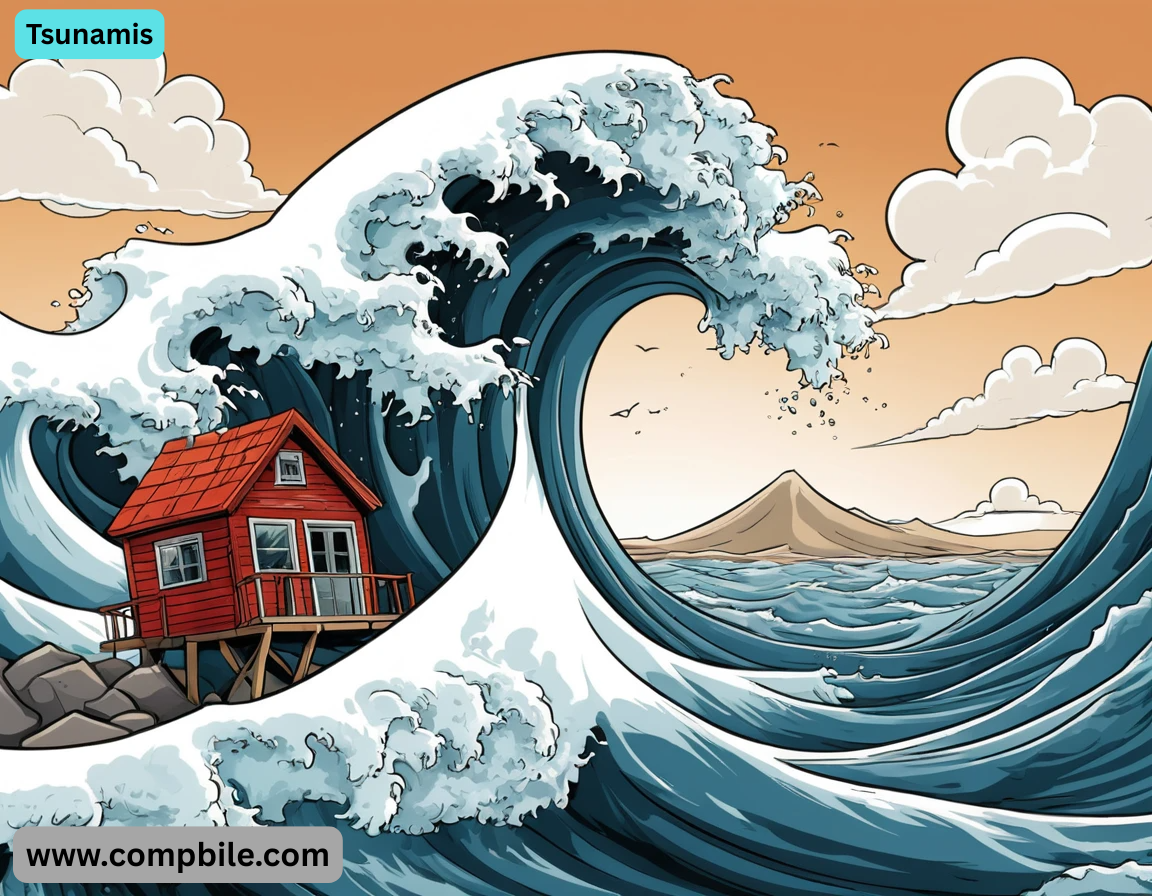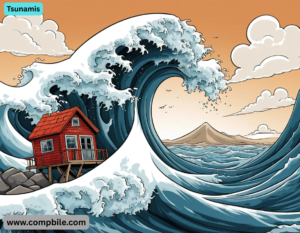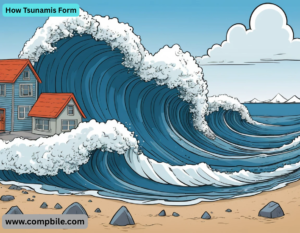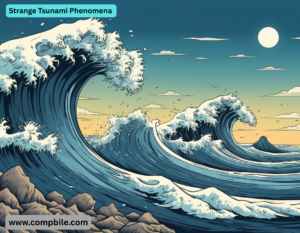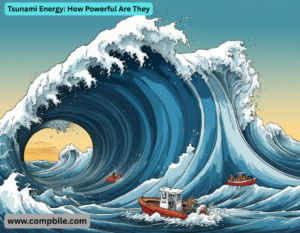Tsunamis Tsunamis are large, powerful ocean waves caused by the sudden displacement of water, typically due to underwater earthquakes, volcanic eruptions, landslides, or even meteorite impacts. They can cause devastating destruction when they reach coastal areas.
Generation:
- Most tsunamis are triggered by undersea earthquakes (especially along subduction zones, like the Pacific Ring of Fire).
- Other causes include volcanic eruptions (e.g., Krakatoa, 1883), landslides (e.g., Lituya Bay, 1958), and glacial calving.
Wave Behavior:
- Unlike normal waves (wind-driven), tsunamis have extremely long wavelengths (up to 200 km) and travel at high speeds (500–800 km/h in deep water).
- As they approach shallow coastal waters, they slow down but grow dramatically in height (surging to 10–30 meters or more).
Impact:
- Tsunamis can flood vast coastal areas, destroying infrastructure, homes, and ecosystems.
Famous Tsunamis in History:
- 1960 Chile Tsunami (largest recorded earthquake, M9.5) → waves crossed the Pacific.
Warning & Mitigation:
- Early Warning Systems (e.g., Pacific Tsunami Warning Center) use seismic sensors and ocean buoys.
- Community Preparedness (evacuation routes, education) saves lives.
How Tsunamis Form
- Submarine Earthquakes (Most common cause, especially megathrust quakes at tectonic plate boundaries).
- Landslides (Underwater or coastal—e.g., Alaska’s 1958 Lituya Bay mega-tsunami reached 524 m high!).
- Volcanic Eruptions (e.g., Krakatoa’s 1883 eruption caused waves killing 36,000).
- Meteorite Impacts (Rare, but dinosaur extinction involved massive tsunamis).
Process:
- Seafloor abruptly shifts, pushing water upward.
- Near shore, waves slow down but stack up into a devastating surge.
Tsunami Detection & Early Warning
Modern systems use:
- Seismometers (Detect earthquakes that may trigger tsunamis).
- DART Buoys (Deep-ocean sensors tracking wave changes).
- Satellite & Coastal Gauges (Monitor sea level in real-time).
Response Time:
- For nearby quakes (e.g., Japan 2011), warnings may give minutes.
- Distant tsunamis (e.g., 2004) allow hours for alerts.
How to Survive a Tsunami
If you’re near the coast and feel:
- Strong shaking (earthquake) → Evacuate immediately!
- Ocean receding (water pulls back) → Run to high ground!
- Official warning → Follow evacuation routes.
Safety Tips:
- Go at least 30 m (100 ft) above sea level or 3 km (2 miles) inland.
- Never stay to watch or return too soon—multiple waves may follow.
- If trapped, climb a strong, tall building (last resort).
Could a Mega-Tsunami Happen Today?
Potential Threats:
- Canary Islands (Cumbre Vieja volcano collapse could send a 300+ ft wave toward the U.S. East Coast—but debated).
- Alaska’s Landslides (Climate change may trigger more collapses).
- Asteroid Impact (A 1-km asteroid could generate a global tsunami).
Strange Tsunami Phenomena
A. Tsunami Bores (Like a Liquid Wall)
- Example: 2011 Japan tsunami had a 10–15 m high bore in some areas.
B. “Tsunami Echoes” (Repeated Waves)
- Tsunamis can reflect off undersea ridges and return hours later.
- 1960 Chile tsunami hit Hawaii, then bounced back from Japan’s coast, hitting Chile again a day later!
C. Meteotsunamis (Weather-Driven “Rogue Waves”)
- Caused by rapid air pressure changes (storms, squall lines).
- 2020 Lake Michigan “tsunami”—a 6 ft wave from sudden winds, swamping boats.
How Animals Sense Tsunamis Before Humans
- Elephants in Sri Lanka (2004) fled inland before the tsunami hit.
- Zoos in Japan (2011) reported animals hiding or acting strangely minutes before the quake.
Possible reasons:
- Sensing infrasound (low-frequency vibrations).
- Detecting electromagnetic changes from tectonic stress.
The Most Extreme Tsunamis in Earth’s History
A. The Chicxulub Impact (Dinosaur Killer, 66 MYA)
- Asteroid ~10 km wide → mega-tsunami 1.5 km high, circling Earth for weeks.
- Evidence found in sediment layers worldwide.
B. Storegga Slide (8,150 Years Ago, Norway)
- Undersea landslide triggered 20 m waves, wiping out early coastal settlements.
C. The “Minoan Eruption” (Santorini, ~1600 BCE)
- Volcanic collapse → 100+ m waves, possibly inspiring the Atlantis myth.
Future Threats & Worst-Case Scenarios
A. Cumbre Vieja Mega-Tsunami (Theoretical)
- If La Palma’s volcano collapses, 300+ ft waves could hit the U.S. East Coast in 6–8 hours.
- Debated: Some models say waves would be smaller (~30 ft).
B. Climate Change Effects
- Melting glaciers → more undersea landslides (e.g., Greenland).
C. AI & Tsunami Prediction
- Machine learning now helps predict wave behavior faster than traditional models.
Bizarre Tsunami Records
- Tallest Modern Tsunami: 1958 Lituya Bay, Alaska (524 m / 1,720 ft).
- Farthest Inland: 2004 Indian Ocean tsunami penetrated 5 km (3 miles) in Sumatra.
- Fastest Tsunami: 1960 Chile tsunami crossed Pacific at 700+ km/h.
Could We Stop a Tsunami? (Wild Engineering Ideas)
- Nuclear Explosions (Theoretically could disrupt waves, but terrible side effects).
Tsunami Myths Debunked
- “A tsunami is just one big wave.” → Actually, it’s a series of waves (like a sloshing bathtub).
- “You can surf a tsunami.” → No! It’s a violent debris-filled surge, not a clean wave.
- “All earthquakes cause tsunamis.” → Only vertical seafloor movement does (not side-to-side quakes).
Want More? Try These Rabbit Holes:
- Why do tsunamis sometimes glow? (Bioluminescence + disturbed plankton!)
- The “Teletsunami” phenomenon (A tsunami that crosses entire oceans).
- Could a tsunami hit the Moon? (Spoiler: No, but asteroid impacts create “lunar tsunamis” of dust!)
Tsunami Energy How Powerful Are They
- The 2004 Indian Ocean tsunami released ~5 megatons of TNT energy (more than 300 Hiroshima bombs).
- The 2011 Japan tsunami carried enough force to move icebergs in Antarctica (detected by seismic sensors).
Energy comparison:
- Normal wind wave: 0.001% of a tsunami’s energy.
- Hurricane storm surge: 1% of a tsunami’s energy.
The “Shadow Zone” Mystery: Why Some Coasts Are Spared
- Due to underwater topography, some areas get almost no waves despite being near the epicenter.
- Example: Sri Lanka in 2004—some western coasts saw 3 m waves, while the east was devastated by 10 m+ surges.
Tsunamis on Other Planets & Moons
- Titan (Saturn’s moon): Methane/ethane lakes could have cryovolcanic tsunamis.
- Jupiter’s Europa: Underground ocean + tectonic activity = possible ice-cracking tsunamis.
The “Tsunami Earthquake” Enigma
- Some quakes barely shake land but trigger massive tsunamis—scientists still don’t fully understand why.
- Example: 1896 Sanriku “Slow Quake” (Japan)
- Magnitude just 7.6, but tsunami waves 38 m (125 ft) high.
- Now called “tsunami earthquakes”—they rupture slower and deeper than normal quakes.
The 1946 April Fools’ Tsunami (Hawaii’s Deadliest Prank)
- April 1, 1946: A tsunami hit Hawaii, killing 159 people.
- Many thought it was an April Fools’ joke until waves smashed ashore.
Can a Tsunami Trigger a Volcanic Eruption?
- Yes! The 2011 Japan tsunami may have destabilized magma chambers under Mount Fuji.
- Historical cases suggest tsunami pressure waves can trigger eruptions within days or weeks.
The “Invisible Tsunami” (Internal Waves)
- Beneath the surface, giant underwater waves (internal solitary waves) can travel hundreds of meters tall without breaking the surface.
- These disrupt submarines, pipelines, and offshore rigs.
The Worst Possible Modern Tsunami Scenario
A. The “Aleutian Megathrust” (Alaska)
- A M9+ quake here could send 30 m (100 ft) waves to Hawaii, California, and Japan within hours.
- Estimated millions at risk—emergency plans are being updated.
B. The “Canary Island Collapse” (La Palma)
- If Cumbre Vieja slides, models predict:
- 50–100 m waves in the Canaries.
- 10–25 m waves on U.S. East Coast (6–8 hours later).
C. A “Stealth Tsunami” (No Warning)
- A landslide-triggered tsunami (like 1958 Lituya Bay) could hit with zero warning.
Unsolved Tsunami Mysteries
- The 1498 “Lost Tsunami” (Japan) – Historical records describe 30 m waves, but no known quake matches.
- The 1700 “Orphan Tsunami” (North America) – Traced to a M9 quake in the Pacific Northwest, but no local records exist.
- The “Dark Tsunami” Effect – Some survivors report water turning black (possibly from churned-up seabed sediment).
How to Harness Tsunami Energy? (Wild Future Tech)
- Underwater “speed bumps” – Slow waves by disrupting flow.
- Tsunami turbines – Experimental tech to convert wave energy into electricity.
- AI-controlled floodgates – Smart barriers that auto-deploy when sensors detect a tsunami.
The “Tsunami-Proof” Civilization Challenge
- Japan’s “Great Wall” – Some coasts now have 15 m seawalls.
- Floating Cities? – Architects propose amphibious buildings that rise with floodwaters.
- Ancient Wisdom: Some Indonesian tribes build houses on stilts after centuries of tsunami experience.
Get article on pdf file….Click now
…..Tsunamis…..

